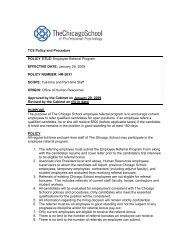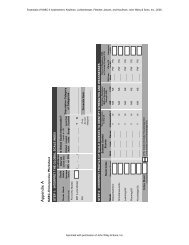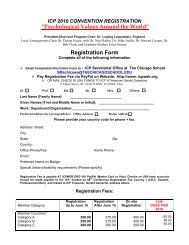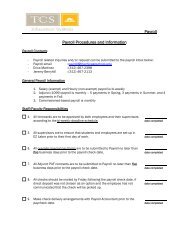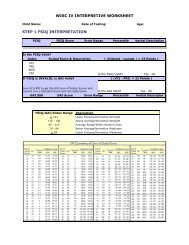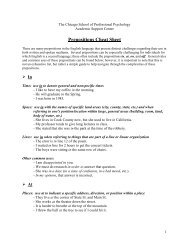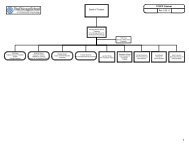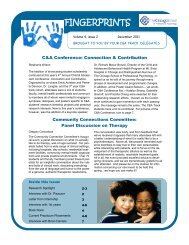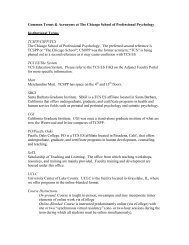YOUR VERY OWN TF-CBT WORKBOOK
YOUR VERY OWN TF-CBT WORKBOOK
YOUR VERY OWN TF-CBT WORKBOOK
Create successful ePaper yourself
Turn your PDF publications into a flip-book with our unique Google optimized e-Paper software.
<strong>YOUR</strong> <strong>VERY</strong> <strong>OWN</strong><br />
<strong>TF</strong>-<strong>CBT</strong><br />
<strong>WORKBOOK</strong><br />
By Alison Hendricks, Judith A. Cohen, Anthony<br />
P. Mannarino, and Esther Deblinger<br />
For personal use only. Please do not distribute without permission<br />
from the authors.
<strong>YOUR</strong> <strong>VERY</strong> <strong>OWN</strong> <strong>TF</strong>-<strong>CBT</strong> <strong>WORKBOOK</strong><br />
TABLE OF CONTENTS<br />
INTRODUCTION<br />
WELCOME TO THERAPY! 1<br />
ABOUT YOU 2<br />
ABOUT <strong>YOUR</strong> FAMILY 3<br />
LEARNING ABOUT UPSETTING/CONFUSING EVENTS 4<br />
HOW DO KIDS FEEL AFTER AN UPSETTING/CONFUSING<br />
EVENT? 5<br />
MORE ABOUT FEELINGS 6<br />
HOW DO WE EXPERIENCE FEELINGS IN OUR BODIES? 7<br />
HOW DO FEELINGS SHOW ON FACES? 8<br />
HOW STRONG OR INTENSE ARE OUR FEELINGS? 9<br />
COPING WITH UPSETTING FEELINGS 10<br />
FEELINGS SURVIVAL KIT 11<br />
WHAT IS RELAXATION? 12<br />
HOMEWORK: LET’S RELAX! 13<br />
BELLY BREATHING 14<br />
<strong>YOUR</strong> SAFE PLACE 15<br />
STOP THAT THOUGHT! 16<br />
THOUGHTS, FEELINGS, AND … ACTION! 17<br />
THOUGHTS MATTER! 18<br />
THOUGHT PROBLEMS 19<br />
NOTICE <strong>YOUR</strong> THOUGHTS! 20<br />
TELLING <strong>YOUR</strong> STORY 21<br />
<strong>YOUR</strong> STORY 22<br />
FEELINGS 1-10 23<br />
<strong>YOUR</strong> THOUGHTS AND FEELINGS ABOUT THE<br />
UPSETTING/CONFUSING EVENT(S) 24<br />
BATTLING TRAUMA REMINDERS 25<br />
SHARING <strong>YOUR</strong> STORY 26<br />
BEING SAFE 27<br />
<strong>YOUR</strong> CIRCLE OF SAFETY 28<br />
<strong>YOUR</strong> FABULOUS FUTURE 29
LET’S REVIEW 30<br />
SAYING GOOD-BYE 31<br />
Introduction<br />
Your Very Own <strong>TF</strong>-<strong>CBT</strong> Workbook<br />
This workbook has been developed for use with children ages six to twelve who have<br />
experienced one or more traumatic events. The activities in the workbook correspond to<br />
the treatment components of the Trauma-Focused Cognitive Behavioral Therapy (<strong>TF</strong>-<br />
<strong>CBT</strong>) model, which was developed by Judith Cohen, Anthony Mannarino, and Esther<br />
Deblinger (Cohen, Mannarino, & Deblinger, 2006). The intended use of the workbook is<br />
by master’s level mental health professionals who have also had training in <strong>TF</strong>-<strong>CBT</strong> and<br />
have read the manual on <strong>TF</strong>-<strong>CBT</strong> (cited above).<br />
The workbook was created as a supplemental resource to assist therapists as they work<br />
through each component of the <strong>TF</strong>-<strong>CBT</strong> model with their child clients. This workbook is<br />
one of the many resources that therapists can use in implementing <strong>TF</strong>-<strong>CBT</strong>, and the<br />
manual cited above provides and extensive list of books, activities, and other therapeutic<br />
aids. The workbook intends to provide a helpful framework to cover each component of<br />
<strong>TF</strong>-<strong>CBT</strong>, but other resources and activities should also be utilized as clinically indicated<br />
(i.e. play therapy, role plays, movement therapy, audio relaxation exercises, therapeutic<br />
board games, etc). Get creative! As always, clinical judgment takes precedence. Some<br />
of the activities included in the workbook may not be appropriate for all children, and<br />
flexibility needs to be balanced with fidelity to the treatment model.<br />
The workbook activities were developed for implementing the components of the <strong>TF</strong>-<br />
<strong>CBT</strong> model: psycho-education, affective regulation and modulation, relaxation,<br />
cognitive coping and processing, creating a trauma narrative, cognitive processing of the<br />
traumatic experience(s), in vivo mastery of trauma reminders, conjoint sessions, and<br />
enhancing future safety and development. The child and parent will initially need some<br />
orientation to <strong>TF</strong>-<strong>CBT</strong>, and issues of confidentiality and sharing of the child’s work need<br />
to be discussed from the outset. The workbook can be completed over the course of 12-<br />
20 weeks, depending on the length of each session and the age/attention span of the child.<br />
Keep in mind that some traumatized children may require other types of treatment before,<br />
during, or after <strong>TF</strong>-<strong>CBT</strong>. The workbook activities correspond to the components of the<br />
<strong>TF</strong>-<strong>CBT</strong> model as follows:<br />
Orientation to Therapy and <strong>TF</strong>-<strong>CBT</strong>, Engagement Pages 1-3<br />
Psycho-education on Trauma and Reactions to Trauma Pages 4-5<br />
Feelings Identification Pages 6-8<br />
Feelings Ratings and Affect Modulation Pages 9-11<br />
Relaxation, Progressive Muscle Relaxation, Deep Breathing Pages 12-14<br />
Positive Imagery and Thought Stopping Pages 15-16<br />
Cognitive Processing Pages 17-20<br />
Creating the Trauma Narrative Pages 21-23
Processing the Traumatic Experience(s) Page 24<br />
In Vivo Mastery of Trauma Reminders Page 25<br />
Conjoint Session – Sharing the Trauma Narrative Page 26<br />
Conjoint Session – Enhancing Future Safety and Development Pages 27-28<br />
Goals, Review, Graduation Pages 29-31<br />
Following the structure of the <strong>TF</strong>-<strong>CBT</strong> model, the therapist meets individually with child<br />
each week to complete the above (and other supplemental) treatment activities. Then the<br />
therapist meets with the parent individually to work with the caretaker on the same<br />
component, to teach him/her the skills to support the child at home and for the caretaker<br />
to process his/her own feelings about the trauma. Sharing the activities completed by the<br />
child in the workbook each week can be a helpful way to work with the parent on the<br />
treatment components, in addition to supplemental resources geared toward parents.<br />
Parents usually appreciate seeing their children’s artwork and writing, and sharing these<br />
provides the opportunity for the therapist to increase the parent’s empathy and<br />
understanding of the child’s experience. The children also generally like the fact that<br />
their parents will get to see their work. Again, use your clinical judgment if the child<br />
does not want you to share a particular page with a parent right away or if sharing is<br />
contra-indicated in any way. Some games or activities may be used during conjoint<br />
sessions in which the child and parent can practice and share together. For example,<br />
children may enjoy teaching their caretaker the Feelings Charades game (Page 8) or Belly<br />
Breathing games (Page 14) and playing together in session. It is important to have<br />
caretakers involved in the safety component (Pages 27-28). Again, flexibility is<br />
important!<br />
Homework activities can be assigned each week for the child, caretaker, or dyad at the<br />
discretion of the therapist. The workbook includes a relaxation activity that is labeled as<br />
homework (it can also be taught or practiced in session) and recommends daily practice<br />
of the deep breathing techniques. You may create games for the dyad to play as<br />
homework, assign thought logs, etc. Use your imagination, and tap into the individual<br />
child’s strengths and interests when planning your interventions.<br />
For further information on <strong>TF</strong>-<strong>CBT</strong> and its components, please refer to the treatment<br />
manual:<br />
Cohen, J.A., Mannarino, A.P., & Deblinger, E. (2006). Treating trauma and traumatic<br />
grief in children and adolescents. New York: Guilford Press.<br />
An additional resource is the on-line <strong>TF</strong>-<strong>CBT</strong> training at: http://tfcbt.musc.edu/ .
WELCOME TO THERAPY!<br />
Therapy is a safe place to help you feel better about upsetting<br />
or confusing events that you have experienced. You will get to<br />
draw, write, talk, and play! You will learn many important<br />
things about: upsetting/confusing events, feelings, relaxation,<br />
and how to stay safe. You will also learn a lot about yourself:<br />
your thoughts, feelings, actions, strengths, and dreams!<br />
Please draw a picture to show how you feel about being here<br />
today:<br />
Do you have any questions about therapy?<br />
1
ABOUT YOU<br />
You are a very special person! There are many special things<br />
about you and a lot of things you are good at. Please draw or<br />
write some of these things:<br />
What are some things you like to do for fun?<br />
2
ABOUT <strong>YOUR</strong> FAMILY<br />
What are some things you like about your family? What do you and<br />
your family like to do together? Please draw or write some of these<br />
things:<br />
3
LEARNING ABOUT UPSETTING/CONFUSING EVENTS<br />
Upsetting/confusing events are also called traumas. These events don’t<br />
happen often, but when they do, they can cause people to feel very afraid,<br />
upset, and helpless. There are different kinds of upsetting/confusing events.<br />
Let’s learn about the upsetting/confusing event(s) that you experienced. Your<br />
therapist will help you find the answers to some common questions kids have<br />
about upsetting/confusing events. (If you have experienced more than one<br />
type of upsetting/confusing event, you can repeat the questions for each one).<br />
What is it called?<br />
What does that mean?<br />
Who does this happen to?<br />
Are there a lot of kids who experience this?<br />
Why does this happen?<br />
What can kids do if this happens to them?<br />
Create your own questions here:<br />
1.<br />
2.<br />
3.<br />
4.<br />
4
HOW DO KIDS FEEL AFTER AN UPSETTING/CONFUSING<br />
EVENT?<br />
Many kids have scary memories or dreams about the upsetting/confusing<br />
event. Some kids also feel jumpy or nervous or angry. After an<br />
upsetting/confusing event, a lot of kids watch out for danger and worry<br />
about bad things happening. Some kids also have trouble sleeping and<br />
paying attention in school. A lot of kids feel like they DON’T want to talk<br />
about or think about the upsetting/confusing thing that happened, but<br />
the memories pop into their minds anyway. When something reminds<br />
them of the upsetting/confusing event, kids may feel upset and may have<br />
strong reactions in their bodies (heart beating fast, stomach ache).<br />
Please circle any of the things above that you have experienced since the<br />
upsetting/confusing event(s). Then draw or write below what kinds of<br />
feelings you think kids have after these kinds of events:<br />
What can kids do about these feelings?<br />
5
MORE ABOUT FEELINGS<br />
Feelings are what we feel in our bodies and hearts. There are<br />
many different feelings that we have, and our feelings may<br />
change from moment to moment. Sometimes we even feel two<br />
or more feelings at the same time!<br />
Please write down as many feelings as you can think of below<br />
on the left side of this paper:<br />
Great! Now put a color next to each feeling to describe the<br />
feeling.<br />
6
HOW DO WE EXPERIENCE FEELINGS IN OUR BODIES?<br />
Remember the feelings and colors you listed on Page 6? We’re going to<br />
use those colors now to show where in your body you experience each<br />
feeling. You don’t have to do all the feelings you listed; you and your<br />
therapist can choose which feelings you want to include. For each feeling<br />
you choose, close your eyes and imagine having that feeling right now.<br />
Where do you experience that feeling in your body? Please color in the<br />
places on your body where you experience each feeling and tell your<br />
therapist what it feels like.<br />
Our bodies tell us how we are feeling!<br />
7
HOW DO FEELINGS SHOW ON FACES?<br />
A good way to tell how we feel and how others feel is by noticing facial<br />
expressions. Please draw the feelings in the circles to show how we<br />
express our feelings on our faces (the last two are blank for you to draw<br />
any feelings you want!):<br />
happy sad mad<br />
scared nervous excited<br />
confused shocked brave<br />
proud<br />
How do you feel right now? You can play a game with your therapist called<br />
“Feelings Charades.” Take turns acting out the above feelings; the other person<br />
tries to guess which feeling you are acting out! Then you get to tell what makes<br />
you feel that way. You can also play this game at home.<br />
8
HOW STRONG OR INTENSE ARE OUR FEELINGS?<br />
Sometimes we feel a feeling just a little bit, and other times we feel a<br />
feeling so strongly that we feel like we might BURST with that feeling!<br />
BURST<br />
You can rate or measure your feelings, just like a thermometer measures<br />
temperature. The number tells how intense the feeling is.<br />
10 <strong>VERY</strong> STRONG<br />
9<br />
8 A LOT<br />
7<br />
6<br />
5 MEDIUM<br />
4<br />
3<br />
2 A LITTLE<br />
1<br />
0 NOT AT ALL<br />
What feelings are you having right now? How would you rate<br />
each of those feelings (on a scale of 1-10)?<br />
9
COPING WITH UPSETTING FEELINGS<br />
When we experience an upsetting feeling very strongly, we can<br />
DO THINGS to lessen the intensity of the feeling. For example,<br />
if your anger is at a 10 (very strong), you can do things to<br />
bring it down to a 1 or 2. What are some of these things you<br />
can do? Please draw a picture of you doing something that<br />
would help bring your anger down:<br />
YOU’RE IN CHARGE OF <strong>YOUR</strong> FEELINGS!<br />
10
FEELINGS SURVIVAL KIT<br />
When you feel very sad, scared, mad, or worried, what are<br />
some things you can do to feel better? What are some things<br />
you can tell yourself that would make you feel better? Please<br />
make a list of things you can do and say to feel better:<br />
Congratulations! You have just made your own personal<br />
Feelings Survival Kit. You can cut out the items from your<br />
list and place them in a special box, bag, or toolkit. Take it<br />
with you so that the next time you feel very upset you will<br />
remember what to do!<br />
11
WHAT IS RELAXATION?<br />
Relaxation is about feeling calm and peaceful. When we are upset, we<br />
often feel tight in our bodies. We feel better when we learn to relax our<br />
bodies and minds! This exercise teaches us how to relax using our<br />
muscles:<br />
Sit comfortably in your chair with your arms at your sides and your feet planted on the<br />
floor. Close your eyes or look down at the ground while you do this exercise. Imagine<br />
that you have a ball of clay in your right hand. Squeeze that ball of clay as hard as you<br />
can! While you are squeezing, feel how tight the muscles of your hand and arm are.<br />
Count to five as you squeeze, then drop the ball of clay and let your hand hang loose.<br />
Feel the difference in the muscles of your hand and arm when they are relaxed. Repeat<br />
to yourself, “My hand is relaxed.” Now do the same thing with your left hand. You can<br />
do this with all the parts of your body one at a time or all at the same time (your<br />
therapist will help you)! Which way would you like to do it? Don’t forget to include all<br />
your muscle groups (arms, feet, legs, stomach, back, chest, shoulders, face).<br />
Please draw two pictures of yourself below:<br />
Tense/Tight/Stressed<br />
Relaxed<br />
What are some things you do that help you feel relaxed?<br />
12
HOMEWORK: LET’S RELAX!<br />
Many kids have trouble calming down or falling asleep at night.<br />
If this ever happens to you, practice this activity at home.<br />
Someone special can read it to you before bedtime or any<br />
other time when you want to relax.<br />
Lie down or sit comfortably somewhere quiet and cozy (your<br />
bed, a couch). Breathe in slowly and out even more slowly.<br />
Close your eyes and imagine you are floating on a soft, fluffy<br />
cloud. You feel very safe on your cloud as it cradles your body<br />
like a hammock. Your whole body feels very relaxed and<br />
heavy. Notice your feet. Your feet feel very relaxed. Your feet<br />
feel so heavy that it would be hard to lift them if you tried.<br />
Now notice your legs. Your legs feel very relaxed. Your legs<br />
feel so comfortable all nestled into your cloud. That nice,<br />
warm, relaxed feeling is slowly traveling up your body, filling it<br />
with peace. Notice your stomach. It feels very calm and filled<br />
with a pleasant warmth. Now be aware of your chest. Your<br />
chest feels relaxed as it moves up and down slowly with each<br />
breath. Notice your neck and shoulders. They feel so tranquil<br />
and heavy. Feel the backs of your shoulders touching the<br />
cloud below you, sinking in gently. Feel how relaxed your<br />
head is right now. It feels very warm, pleasant, and heavy.<br />
Your head and face are very relaxed. Your mouth and eyes are<br />
free of stress. Allow your thoughts to come and go without<br />
worrying about anything. Everything is okay, and you are<br />
feeling very calm and good. Enjoy the warm, calming<br />
sensation as it travels all around your body, filling you with<br />
peace and relaxation.<br />
13
BELLY BREATHING<br />
Sometimes when we are upset, we forget to breathe! Or we<br />
take short, shallow breaths (like a puppy dog panting) that<br />
don’t give our bodies the oxygen we need. To help ourselves<br />
feel relaxed and calm, we can practice BELLY BREATHING!<br />
Belly breathing is when you breathe in slowly and deeply<br />
(counting to 5 in your head) as your belly and lungs fill up with<br />
air (you can watch your belly stick out as you breathe in!).<br />
Then you let the air out, EVEN SLOWER (count to 6) and watch<br />
your belly go back in as the air is slowly pushed out. Pay<br />
attention to the air as it moves in and out of your body as you<br />
count.<br />
Fun games with belly breathing:<br />
1. Use Belly Breathing Balloons to show how your belly fills up with air as<br />
you breathe in and goes down when you push the air out. Have your<br />
therapist blow up one of the balloons as you breathe in, then slowly let<br />
air out of the balloon as you breathe out. Watch the Belly Breathing<br />
Balloon as it gets bigger and smaller, just like your belly when you are<br />
doing belly breathing! Then switch! YOU make your own balloon get<br />
bigger and smaller as your therapist breathes in and out (slowly!).<br />
2. Decorate your Belly Breathing Balloon any way you want. Then lie on<br />
your back on the floor or lean back in your chair and place the balloon on<br />
your belly. Watch your Belly Breathing Balloon rise up on your belly like a<br />
hot air balloon as you breathe in and land gently as you breathe out.<br />
Your therapist can do this with you if you want.<br />
Teach these games to someone you care about and practice at<br />
home (at least once a day)!<br />
14
<strong>YOUR</strong> SAFE PLACE<br />
Please close your eyes (or look down) and take a few minutes to think<br />
about a place (real or imaginary) where you feel very safe, calm, and<br />
happy. You can tell your therapist once you have your safe place in mind.<br />
Now draw a picture of your safe place below. Add as many details as you<br />
can to show what you see, hear, smell, taste, and feel l when you are in<br />
your safe place.<br />
Wonderful! You can close your eyes and imagine you are in your safe<br />
place when you feel scared or tense. When you think about your safe<br />
place, remember all the details that you drew in this picture!<br />
15
STOP THAT THOUGHT!<br />
Sometimes we think about bad things over and over (like a song you<br />
don’t like that gets stuck in your head). We’ll call this a bad song,<br />
because it can make us feel really bad! But guess what? You can stop<br />
that bad song! All you have to do is notice when that bad song plays in<br />
your head. As soon as you hear it, press STOP! You can also say, “Go<br />
away, bad song!” And then you can sing yourself a happy song (one<br />
that makes you feel good)!<br />
How does your bad song go? You can write or draw your bad song here:<br />
How does your happy song go? Write some of the words or draw a<br />
picture of your happy song here:<br />
Let’s practice! Sing your bad song right now in your head. When I say<br />
STOP, start singing your happy song instead. Now you can decide when<br />
to press STOP on your bad song and PLAY your happy song!<br />
16
THOUGHTS, FEELINGS, AND… ACTION!<br />
What are thoughts? Thoughts are the ideas we have in our heads (what<br />
our brains tell us). Sometimes we say things to ourselves in our heads<br />
(not out loud), and these are also thoughts. For example, you might<br />
think, “I did a great job on my homework.” Can you think of some other<br />
thoughts?<br />
What are feelings? Feelings are the emotions and sensations we have in<br />
our bodies and hearts (you already know a lot about feelings!). What are<br />
some feelings you know about?<br />
What are actions? Actions are the things we do with our bodies! For<br />
example, we walk, dance, talk, draw, laugh, cry, etc. Can you name some<br />
other actions?<br />
Thoughts, Feelings, and Actions Game<br />
This is a game to help you learn the difference between thoughts,<br />
feelings, and actions. Put a blue X the items that are thoughts. Put a<br />
green X next to the items that are feelings. Put a red X next to items that<br />
are actions.<br />
HAPPY<br />
RUNNING<br />
I’M SMART!<br />
HITTING<br />
THEY DON’T LIKE ME<br />
SAD<br />
PLAYING<br />
MAD<br />
I CAN DO IT!<br />
IT’S MY FAULT<br />
WORRIED<br />
HIDING<br />
CRYING<br />
SINGING<br />
LONELY<br />
SHE’S MAD AT ME<br />
EATING ICE CREAM<br />
TAKING A WALK<br />
EXCITED<br />
I’LL BE OK<br />
SCARED<br />
TAKING A DEEP BREATH<br />
HOPPING ON ONE FOOT<br />
BRAVE<br />
TALKING TO A FRIEND<br />
SAFE<br />
17
THOUGHTS MATTER!<br />
Our thoughts affect the way we feel and how we act. When something<br />
happens, we form thoughts about the event that lead to feelings and<br />
actions. The way we talk to ourselves in our heads also affects how we<br />
feel and what we do.<br />
Thoughts<br />
Behavior<br />
Feelings<br />
What are the characters below thinking? How do their thoughts make<br />
them feel?<br />
Thought: Thought: Thought:<br />
Feeling: Feeling: Feeling:<br />
18
THOUGHT PROBLEMS<br />
Sometimes we all have thoughts that either aren’t true or don’t help us to<br />
feel better or solve problems. Some of these thought problems involve<br />
thinking that everything has to be all or nothing (i.e. “One person made<br />
fun of me, so that means everyone hates me”). Other thought problems<br />
focus on the worst possible outcome (i.e. “If my mom goes out, I’m sure<br />
something terrible is going to happen to her”). We sometimes get stuck<br />
in negative thinking (i.e. “Nothing ever works out for me” or “I’ll never<br />
feel OK again”). Please write or draw some problem thoughts that you’ve<br />
had recently.<br />
How did these thoughts make you feel?<br />
19
NOTICE <strong>YOUR</strong> THOUGHTS!<br />
When you feel bad, what are you saying to yourself in your head? It’s<br />
probably the thought that’s making you feel bad. But guess what? If you<br />
practice, you can change your thoughts! Try doing this below. First write<br />
a thought that makes you feel bad and write down the feeling it causes.<br />
Then write a different thought that would make you feel better and write<br />
down the new feeling.<br />
What actions might you take in the first situation? What about in the<br />
second situation? Do these actions lead to different results? Which<br />
results work out better for you?<br />
20
TELLING <strong>YOUR</strong> STORY<br />
You’ve learned a lot so far about upsetting/confusing events, feelings,<br />
coping, relaxation, and thoughts. Congratulations! These are all<br />
important things that will help you as you begin to tell about the<br />
upsetting/confusing event(s) that happened to you. You get to decide<br />
where you want to start and how you would like to tell your story (you<br />
and your therapist can talk about all the different ways for kids to tell<br />
their stories). As you’re telling about what happened to you, your<br />
therapist will help you check in on your feelings (using the “Feelings 1-<br />
10” worksheet on Page 23). If you start feeling strongly upset, you can<br />
stop, and your therapist will help remind you of ways to manage your<br />
feelings. You’re in charge! Please draw or write below to describe how<br />
you feel about starting your story.<br />
21
<strong>YOUR</strong> STORY<br />
Now it’s time for you to decide how you would like to tell your story.<br />
Some kids like to make their own book, while other kids like to express<br />
what happened to them using poetry, songs, cartoon strips, puppet<br />
shows, radio/talk shows, etc. You and your therapist can talk about<br />
creative ways to tell about the upsetting/confusing thing(s) that<br />
happened to you. You get to decide what form you want your story to<br />
take. Don’t forget to use the “Feelings 1-10”<br />
10” worksheet (on the next<br />
page) for each session!<br />
The title of my story is:<br />
This is how I will create my story:<br />
22
FEELINGS 1-10<br />
10<br />
Remember when you used the thermometer to measure your feelings<br />
back on Page 9? Each time you meet with your therapist to tell your<br />
story, you will name and rate your feelings at the beginning, middle, and<br />
end of the session on this paper (make 1 copy of this worksheet for every<br />
trauma story session). Please rate your feelings on a scale of 1-10 to<br />
describe the intensity of the feeling (1=a little bit, 5=medium, 10=very<br />
strong, etc.). You and your therapist will then come up with a plan to<br />
help you manage any difficult feelings that may come up between<br />
sessions (don’t forget to use your Feelings Survival Kit!).<br />
Date:<br />
Status<br />
Beginning of Session<br />
Feeling(s)<br />
Rating<br />
Middle of Session<br />
End of Session<br />
Self-Care Plan:<br />
23
<strong>YOUR</strong> THOUGHTS AND FEELINGS ABOUT THE<br />
UPSETTING/CONFUSING EVENT(S)<br />
Remember how we learned that our thoughts are important? Your thoughts related to<br />
the trauma affect how you feel. These thoughts can help you feel better more quickly,<br />
or they can keep you feeling upset. Let’s look at some of your thoughts related to the<br />
trauma. Below is a list of questions and thoughts that kids often have after an<br />
upsetting/confusing event. You and your therapist can choose which questions you will<br />
discuss, and you can add your own questions or thoughts at the end of the list. Then,<br />
for each question, you can write down the answer that is most helpful.<br />
1. Why did this happen to me?<br />
2. Who is responsible for the upsetting/confusing event(s)?<br />
3. How will the upsetting/confusing event(s) affect me in the future?<br />
4. How have the upsetting/confusing events affected my family?<br />
5. Since the event(s), my view of the world has changed in these ways:<br />
6. Since the event(s), my view of myself has changed in these ways:<br />
7. Since coming to therapy, I have learned these things about myself:<br />
8. Coming to therapy has changed me and my family in these ways:<br />
7. If I had a friend that went through a similar upsetting/confusing event, I<br />
would give him or her this advice:<br />
9. If my friend thought that talking about the upsetting/confusing event<br />
would be too hard, I would tell him or her:<br />
10.<br />
11.<br />
12.<br />
24
BATTLING TRAUMA REMINDERS<br />
Now that you have bravely told your story and talked about your thoughts<br />
and feelings, let’s talk about trauma reminders. Trauma reminders are<br />
things that remind you about the upsetting/confusing event(s). They can<br />
include certain places, people, words, sounds, smells, sensations, etc.<br />
When you experience these reminders, you may feel unsafe or as if you<br />
were living through the upsetting/confusing event(s) over again. But you<br />
can use your coping and relaxation skills to gain control over these pesky<br />
reminders! Please draw or write a few of your trauma reminders below.<br />
Now you and your therapist will come up with a battle plan to conquer<br />
each trauma reminder, one by one. Then you can practice in session to<br />
gain control over these trauma reminders in your life!<br />
25
SHARING <strong>YOUR</strong> STORY<br />
Great job! You did it! You have been very brave in telling your story and<br />
talking about your thoughts and feelings. It can help to share your story<br />
or to talk about the trauma(s) with someone you trust. How would you<br />
feel about sharing your story with a special someone? Please draw a<br />
picture or write about sharing your story or talking about the<br />
upsetting/confusing event(s) with your special person.<br />
What are some questions you would like to ask your special person? These can<br />
be questions you have about the upsetting/confusing event(s) or a quiz to test<br />
how much your special person remembers (about your story, what you have<br />
learned in therapy, etc.).<br />
1.<br />
2.<br />
3.<br />
4.<br />
26
BEING SAFE<br />
We do a lot of things every day to keep ourselves safe. What are some<br />
new things you’ve learned about safety since coming to therapy? Please<br />
draw a picture of you doing something to keep yourself safe.<br />
What are some things other people can do to help keep you safe?<br />
1.<br />
2.<br />
3.<br />
4.<br />
5.<br />
27
<strong>YOUR</strong> CIRCLE OF SAFETY<br />
There are a lot of people who care about you and your safety. These are<br />
people you can go to if you need help or if you want someone to talk to.<br />
Please draw a picture of yourself on the middle of this page. Then create<br />
your circle of safety by drawing and/or writing the names of all the<br />
people who help keep you safe around you. You can include their phone<br />
numbers, too!<br />
28
<strong>YOUR</strong> FABULOUS FUTURE<br />
What hopes, dreams, and goals do you have for your future?<br />
Please draw or write some of them in the space below.<br />
You can achieve anything you set your mind to!<br />
29
LET’S REVIEW<br />
What have you learned in therapy? What was your favorite<br />
part? What was your least favorite part? Please write or draw a<br />
picture to show a special memory or lesson you want to take<br />
with you from therapy.<br />
30
SAYING GOOD-BYE<br />
How do you feel about saying good-bye? How do you feel<br />
about graduating? You can use this final page to show all the<br />
feelings you’re having right now, using words, art, etc., OR you<br />
can draw a picture of you and your therapist saying good-bye.<br />
Congratulations on all your hard work! You did it! You<br />
finished your book!<br />
31



